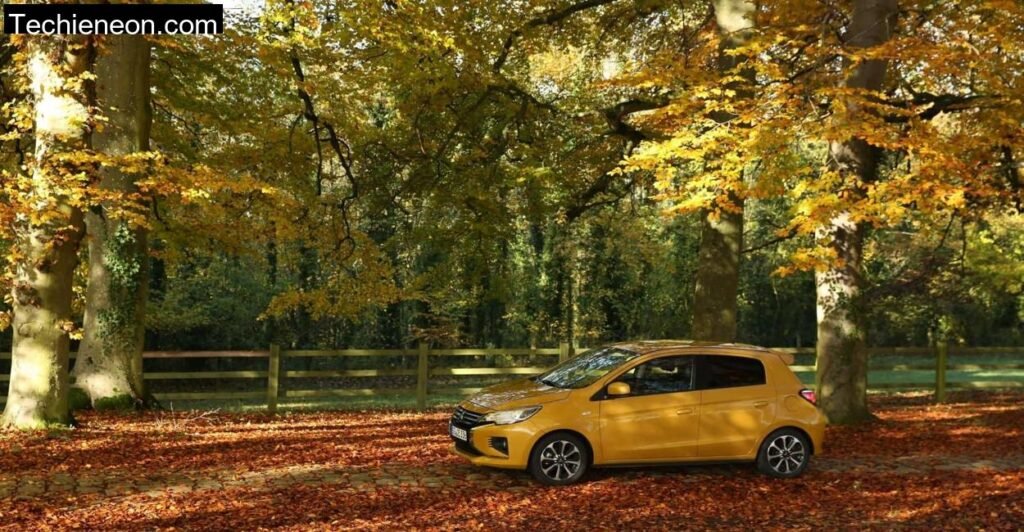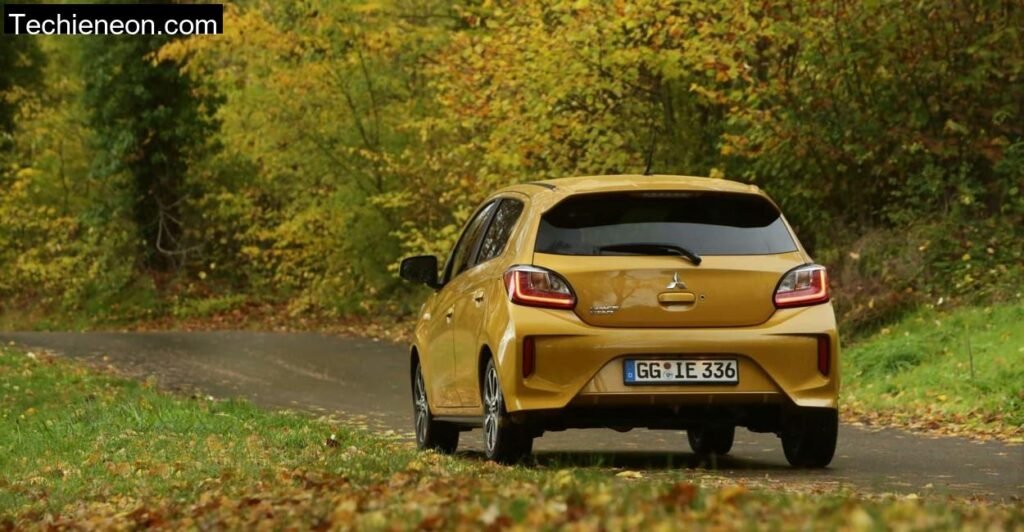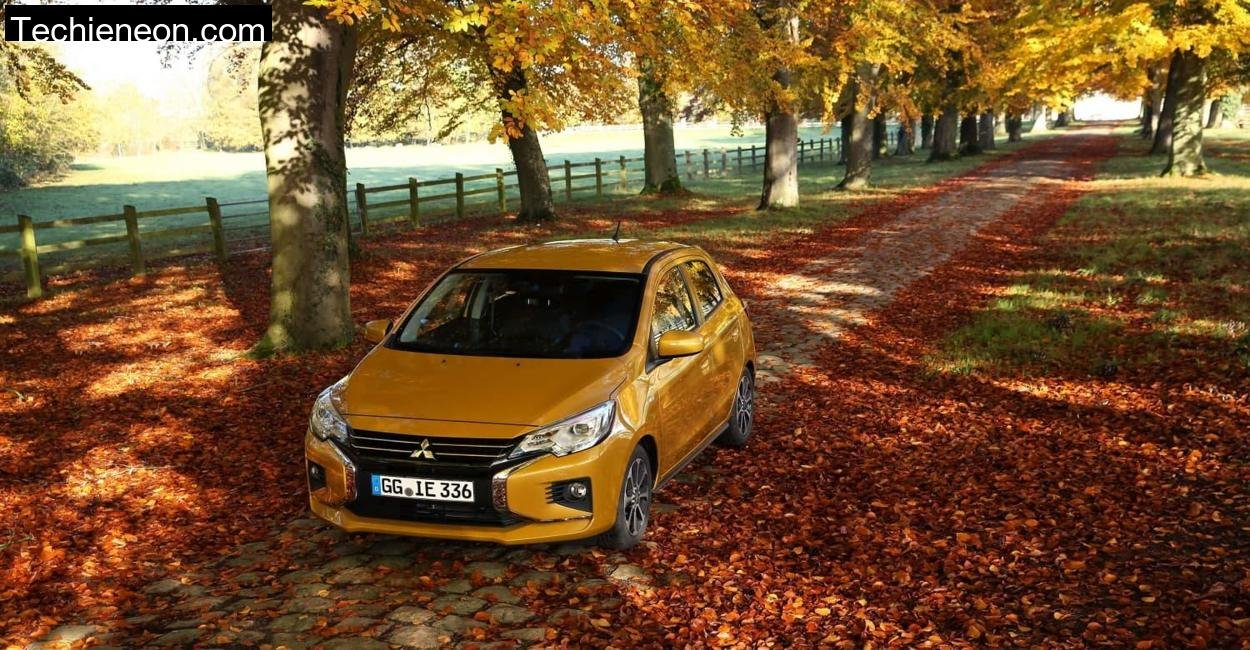Mitsubishi Space Star: Dimensions and Trunk
Standing before the Space Star, the 2020 facelift features still hold up decently. The sculpted front fascia with its chrome “Dynamic Shield” touches and those independent fog lamp pods lend the car a bit of visual backbone. But its stance? Still undeniably petite.
At 3.85 meters long and just 1.67 meters wide, the car remains firmly in the subcompact category. These dimensions came into their own when weaving through the dense forest lanes near the Schwarzer Grat summit.
Mitsubishi’s space management is functional, not generous. The 160-liter trunk (as measured by ) barely held my weekend duffel and a camera tripod. But flip the rear bench, and you get a useable 880 liters, enough for a crate of mineral water and my muddy hiking boots. The five-door setup proves helpful, especially when parked against the tight rock faces near the trailhead. But three adults in the back? Only if they’re exceptionally friendly.
Travel Cheaply with the Space Star

At under €12,000 with the factory discount, the Space Star competes almost exclusively with the Dacia Sandero in the price-is-right Olympics. But frugality comes with conditions.
The Select+ model I tested offered basic comforts, manual air conditioning, a 7-inch touchscreen, and cruise control, but nothing in the realm of modern assist systems. No lane-keep, no blind-spot, not even a reversing camera.
Yet, as I descended Schwarzer Grat’s steep switchbacks, this simplicity became… refreshing. No bongs, no flashing icons, just focus. The drive was raw, but not overwhelming. As far as budget travel goes, the Space Star doesn’t hide what it lacks, it just leans harder into its honesty.
Only Engine: A 71 hp Three-Cylinder
The single-engine option is as old-school as it gets: a naturally aspirated 1.2-liter three-cylinder, pushing out 71 hp and 102 Nm of torque. No turbo, no hybrid boost. Just three pots and a five-speed gearbox.
Climbing Schwarzer Grat, I had to wring this engine’s neck to get anything close to brisk progress. Second gear did most of the work through the inclines. You can hear each combustion pulse, low, raspy, familiar. At 6,000 rpm, the engine feels like it’s yelling its little heart out, but it never gives up.
Acceleration from 0–100 km/h takes 14.1 seconds, and the car tops out at 167 km/h. But what surprised me was how the car encouraged a kind of spirited driving, despite the stats. On the right road, at the right pace, it can still feel alive, barely.
Weaknesses in Driving Characteristics

Flat out: the Space Star doesn’t like to be rushed. On the twisty descent from the Schwarzer Grat’s southern ridge, its soft suspension leaned dramatically in every bend. The body roll was pronounced enough to make a thermos roll across the backseat.
Mid-corner bumps? The chassis got unsettled. The car skipped, lost composure, then caught itself with a shrug. There’s no real feedback through the thin-rimmed wheel, just a vague sense of direction. And yet, there’s a charm to its roughness. It reminded me of driving my first car, when limits were lower but engagement was higher.
Still, one must be honest: compared to even modest modern compacts, the Space Star feels outdated in dynamics.
No Glory: Steering and Braking Distance
The steering is the biggest letdown. It lacks centering force, feels inconsistent, and requires constant correction on longer straights. On a fast downhill section with subtle cambers, I found myself tensing up, never fully trusting the front axle’s commitment.
And the braking performance? Serviceable, but far from impressive. At 37.7 meters from 100 km/h, the stopping distance is okay, but there’s not much pedal feel, and emergency braking lacks confidence. If a deer had darted out near those Schwarzer Grat bends, the outcome would’ve depended more on reaction time than on stopping power.
Space Star with Five-Year Warranty
Here’s where Mitsubishi redeems itself. A five-year/100,000 km warranty is rare at this price point, and it adds peace of mind to a purchase that’s otherwise very conservative.
Mitsubishi also offers niche accessories: a delivery rack, a tow-bar-mounted bike carrier (yes, I checked, they still sell one), and even a “lowered” visual kit that feels more like cosplay than performance.
It’s thoughtful, even if it’s not particularly exciting. The Space Star won’t win hearts through thrill. It wins by quietly promising reliability.
Conclusion
Driving the Mitsubishi Space Star on the Schwarzer Grat was like taking an old friend on one last hike. It complained a bit, huffed and puffed up the steeper sections, and grumbled through the corners, but it never gave up.
Yes, it’s outdated. It lacks modern assists, dynamic sharpness, and premium feel. The overall score of 4.1 reflects its limitations in safety and refinement. But as a barebones, honest small car for short commutes, young drivers, or city dwellers on a budget, it still has a role to play.
If you see one at the dealer, maybe don’t walk away just yet. Ask it to take you up a hill. You might be surprised how much life is left in this little star.


Leave a Comment